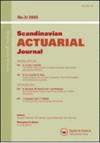具有终端分配约束的保险优化问题
IF 1.4
3区 经济学
Q3 MATHEMATICS, INTERDISCIPLINARY APPLICATIONS
引用次数: 0
摘要
本文研究了保险公司在确定性有限时间T的终端盈余服从具有给定均值和给定方差的正态分布的约束下的两种优化设置。在这两种情况下,都假定保险公司的盈余遵循有漂移的布朗运动。首先,我们允许保险公司支付股息,并寻求在终端分配约束下最大化预期贴现股息支付或最小化破产概率。在这里,我们找到了当股利策略在离散时间点和连续时间点更新时两种情况下的最优策略的显式表达式。第二,我们让保险公司为被保险人或业务分支购买再保险合同。我们将初始资本设置为零,以验证保费是否足以购买再保险,并以这样一种方式管理传入索赔的风险,即在没有外部帮助的情况下,在某个终端时间达到预期的风险特征(例如,用正初始资本表示)。我们只允许分段不变再保险策略产生正态分布的终端盈余,其均值和方差导致给定的风险值或在某种置信水平α下的预期缺口。我们研究了当破产检查在离散的确定性时间点上到期时,哪种允许再保险策略产生更小的破产概率的问题。本文章由计算机程序翻译,如有差异,请以英文原文为准。
Some optimisation problems in insurance with a terminal distribution constraint
In this paper, we study two optimisation settings for an insurance company, under the constraint that the terminal surplus at a deterministic and finite time T follows a normal distribution with a given mean and a given variance. In both cases, the surplus of the insurance company is assumed to follow a Brownian motion with drift. First, we allow the insurance company to pay dividends and seek to maximise the expected discounted dividend payments or to minimise the ruin probability under the terminal distribution constraint. Here, we find explicit expressions for the optimal strategies in both cases, when the dividend strategy is updated at discrete points in time and continuously in time. Second, we let the insurance company buy a reinsurance contract for a pool of insured or a branch of business. We set the initial capital to zero in order to verify whether the premia are sufficient to buy reinsurance and to manage the risk of incoming claims in such a way that the desired risk characteristics are achieved at some terminal time without external help (represented, for instance, by a positive initial capital). We only allow for piecewise constant reinsurance strategies producing a normally distributed terminal surplus, whose mean and variance lead to a given Value at Risk or Expected Shortfall at some confidence level α. We investigate the question which admissible reinsurance strategy produces a smaller ruin probability, if the ruin-checks are due at discrete deterministic points in time.
求助全文
通过发布文献求助,成功后即可免费获取论文全文。
去求助
来源期刊

Scandinavian Actuarial Journal
MATHEMATICS, INTERDISCIPLINARY APPLICATIONS-STATISTICS & PROBABILITY
CiteScore
3.30
自引率
11.10%
发文量
38
审稿时长
>12 weeks
期刊介绍:
Scandinavian Actuarial Journal is a journal for actuarial sciences that deals, in theory and application, with mathematical methods for insurance and related matters.
The bounds of actuarial mathematics are determined by the area of application rather than by uniformity of methods and techniques. Therefore, a paper of interest to Scandinavian Actuarial Journal may have its theoretical basis in probability theory, statistics, operations research, numerical analysis, computer science, demography, mathematical economics, or any other area of applied mathematics; the main criterion is that the paper should be of specific relevance to actuarial applications.
 求助内容:
求助内容: 应助结果提醒方式:
应助结果提醒方式:


